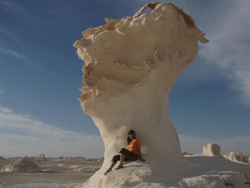About Egypt
|
|
Oases
Egypt 's oases are just that: unspoilt refuges from the modern world, pockets of civilization in the dramatic setting of the desert. Surrounded by sand and sky, the oases have a sense of timelessness, rare in the 21st century. Man and nature have coexisted here since the Stone Age, but the stars, the rock formations and the dunes defy the calculation of human calendars.
Egypt 's oases are still the most varied in the world, each with a distinguished character of its own. Wherever you stay, enjoy the tranquility of the Bedouin life-style, the date groves and pigeon towers.
For adventure and excitement, Tarot Tours Garranah organizes safari trips to the following western desert oases to explore the majesty of the desert by jeep and on cales safari and to spend the nights under the stars.
Fayum
Its name was originated from the ancient Egyptian name Payoum which meant "the Sea", a reference to the large inland Lake Qaroun. It is a depression in the western desert 103 km south west of Cairo. It is famous for its water wheels which were introduced by the Ptolemies in the 3rd century BC. There are many Pharaonic sites in the area as it was the cult center of the Crocodile God Sobek in ancient times. The diversity of its nature and serene beauty, waterfalls and springs make it a perfect place for fishing, hunting and bird watching.
|
 |
Baharia Oases
Located 365 km south west of Giza. Intertwined trees provide attractive scenery contrasted by massive sand dunes. It is rich in wildlife of migrant birds and deer. This oasis is also famous for its 398 mineral and sulphur springs. It also has many archaeological sites which belong to the 26th dynasty including Alexander the Great Temple and also the largest Necropolis dedicated to the Ibis bird as well as ancient churches and palaces. "The Valley of the Golden Mummies" has been recently discovered in a Roman Necropolis.
|
 |
The New Valley
Located 625 km from Cairo, its history goes back to 5000 BC. It includes the following three main oases:
|
Al-Kharga
Used to be the last but one stop on the Forty Day Road, the infamous slave-trade route between North Africa and the tropical south. One of its major sites is the Temple of Hibis, built on the site of a Saite, Persian and Ptolemaic settlement. One of the few Persian monuments in Egypt (6th century BC). The Necropolis of Al-Bagawat houses 263 mud-brick tombs with Coptic murals including the remains of one of the oldest churches in Egypt. Thermal springs to the south, are famous for water temperatures up to 43 degrees reputed to be good for the treatment of rheumatism and allergies.
|
 |
Al-Dakhla
Located 200 km west of Al-Kharga, dominated on its northern horizon by a wall of rose-colored rock. Fertile cultivated areas are dotted between sand dunes along the roads from Farafra and Kharga in an area of outstanding natural beauty. Its capital Mut is an ancient city that dates back to the Pharaonic period. A rich oasis which houses Pharaonic, Greco-Roman and Islamic monuments, as well as natural springs and wells.
|
 |
Farafra
Located between Baharia and Dakhla and known as Ta-Iht the Land of the Cow in ancient history. It is an isolated village of which the oldest part lies on a hillside. It houses Roman buildings and its museum exhibits, paintings and ceramics by local artists and sculptures made of materials available in the desert. Beautiful hand-knitted camel hair sweaters, socks and scarves are also local products.
|
 |
The White Desert
A spot which no visitor to the New Valley should miss. Coming from Baharia, you will cross the Black Desert passing by Roman ruins and an old Coptic church with graffiti. Baharia and Frafra are separated by huge golden sand dunes which make a stunning bakdrop to the journey. Once you enter the White Desert you meet a unique landscape of surreal wind-eroded rock formations which is particularly fascinating at sunrise and sunset
|
 |
Siwa
One of the most fascinating oases on the edge of the Great Sand Sea. Its rich history includes the visit of Alexandar the Great to the Prophecy Temple of God Amun in 331 BC. Siwans have their own culture and customs and they speak a Berber language "Siwi" rather than Arabic. It remains one of the best places to buy jewelry, rugs, baskets, traditional robes and head dresses decorated with antique coins. A beautiful view of the whole oasis can be seen after climbing through the ruins of its old city
|
 |
|
| |
|
|